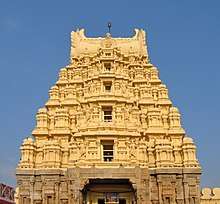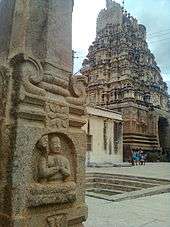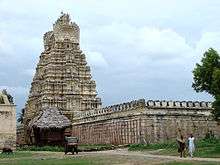Ranganathaswamy Temple, Srirangapatna
| Sri Ranganatha Swamy temple | |
|---|---|
 The temple gopuram | |
 Location within India  Ranganathaswamy Temple, Srirangapatna (Karnataka) | |
| Geography | |
| Coordinates | 12°25′29″N 76°40′47″E / 12.4247524°N 76.6797229°ECoordinates: 12°25′29″N 76°40′47″E / 12.4247524°N 76.6797229°E |
| Country | India |
| State | Karnataka |
| Locale | Srirangapatna |
| Location | Karnataka, India |
| Culture | |
| Sanctum | Ranganatha (Vishnu) |
| Major festivals | Sri Vaishnavism festivals |

The Ranganthaswamy temple (usually referred to as "Sri Ranganathaswamy") in Srirangapatna, in the Mandya district of Karnataka state, India, is dedicated to the Hindu god Ranganatha (a manifestation of the god Vishnu). It is one of the five important pilgrimage sites of Sri Vaishnavism along the river Kaveri for devotees of Ranganatha. These five sacred sites are together known as Pancharanga Kshetrams in Southern India. Since Srirangapatna is the first temple starting from upstream, the deity is known as Adi Ranga (lit; "first Ranga").[1] The town of Srirangapatna, which derives its name from the temple, is located on an island in the river Kaveri.
History
According to the Archaeological Survey of India (ASI), the temple is one of considerable antiquity. An inscription at the temple reveals it was first consecrated in 984 A.D. by a local chief called Tirumalaiah, a vassal of the Western Ganga dynasty. In early 12th century, Hoysala King Vishnuvardhana (r.1108-1152) granted the village of Srirangapatna to the Vaishnava saint Ramanujacharya as an agraharam (place of learning). An inscription of the great Hoysala King Veera Ballala II (1210 A.D.) confirms that additions and renovations were made to the temple at that time.[2] The tower over the entrance bears features consistent with Vijayanagara architecture. According to historian George Michell, contributions were also made by the Wodeyar kings of the Kingdom of Mysore.[2][3] The temple is protected by the Archaeological Survey of India as a monument of national importance.[4] According to historian K.V. Soundararajan, the Rangantha temples in South India built during the 9th and 10th centuries have a systematic arrangement of subsidiary deities as seen in this temple along with the Appakkudathaan Perumal Temple at Koviladi, Sowmya Narayana Perumal temple at Thirukoshtiyur, Veeraraghava Perumal Temple at Mannargudi and Rajagopalaswamy temple at Mannargudi.[5]
Temple plan
The temple has an imposing tower over the entrance gate (gopura) and two large concentric rectangular enclosures (prakara) around its perimeter. The entrance to the inner sanctum (garbhagriha) is through multiple columned halls (mantapa).[3] A vestibule (sukhanasi), hall (navaranga or just mantapa) and a front hall (mukhamantapa) are the other main structures in the temple. The roof of the mukhamantapa is decorated with a "garland" ("hara") of miniature decorative towers (called "kudu" and "sala" shikharas) whose niches contain stucco images of the god Vishnu.[2]
In the sanctum, the image of Vishnu reclines on the coils of the snake Adisesha, under a canopy formed by the snake's seven hoods, with his consort Lakshmi at his feet. Flanking Vishnu are other deities from the Hindu pantheon; Sridevi, Bhudevi (goddess of earth) and Brahma (the creator). There are other smaller shrines within the complex dedicated to Narasimha (an avatar of Vishnu), Gopalakrishna, Srinivasa (manifestation of Vishnu), Hanuman, Garuda and the Alwar saints.[2]
The five sacred sites
The following temples are considered the five sacred sites of worship of the god Ranganatha and are together called Pancharanga Kshetram (Pancha-"five", ranga-"Ranganatha", Kshetram-"sites").[1][6]
| Temple | Location |
| Sri Ranganathaswamy Temple | Srirangapatna |
| Sri Ranganatha Swamy Temple | Srirangam |
| Sarangapani Temple | Kumbakonam |
| Sri Appakkudathan Temple | Trichy |
| Parimala Ranganatha Perumal Temple | Indalur, Mayiladuthurai |
Gallery
 A profile of the gopuram (tower) over entrance in the Ranganathaswamy temple at Srirangapatna
A profile of the gopuram (tower) over entrance in the Ranganathaswamy temple at Srirangapatna A view of the entranace into the main temple hall (mukhamantapa) with Vishnu avatars such as Narasimha, Vamana, Rama and Krishna on top
A view of the entranace into the main temple hall (mukhamantapa) with Vishnu avatars such as Narasimha, Vamana, Rama and Krishna on top Lathe turned pillars, a Hoysala addition to the temple, in the inner open mantapa (hall) in the Ranganathaswamy temple at Srirangapatna
Lathe turned pillars, a Hoysala addition to the temple, in the inner open mantapa (hall) in the Ranganathaswamy temple at Srirangapatna A view of the prakara (bounding wall) in the Ranganathaswamy temple at Srirangapatna
A view of the prakara (bounding wall) in the Ranganathaswamy temple at Srirangapatna_in_Sri_Ranganathaswamy_temple_at_Srirangapatna.jpg) A relief sculpture on a minor shrine on a pedastal in the Ranganathaswamy temple at Srirangapatna
A relief sculpture on a minor shrine on a pedastal in the Ranganathaswamy temple at Srirangapatna_in_Sri_Ranganathaswamy_temple_at_Srirangapatna1.jpg) A relief sculpture on a minor shrine on a pedastal in the Ranganathaswamy temple at Srirangapatna
A relief sculpture on a minor shrine on a pedastal in the Ranganathaswamy temple at Srirangapatna_in_Sri_Ranganathaswamy_temple_at_Srirangapatna.jpg) An open mantapa (hall) inside the complex in the Ranganathaswamy temple at Srirangapatna
An open mantapa (hall) inside the complex in the Ranganathaswamy temple at Srirangapatna Chariot at Sri Ranganathaswamy temple
Chariot at Sri Ranganathaswamy temple
See also
Notes
- 1 2 Dalal (2011), p339
- 1 2 3 4 "Sri Ranganathaswamy Temple". Archaeological Survey of India, Bengaluru Circle. ASI Bengaluru Circle. Retrieved 21 Dec 2013.
- 1 2 Michell (1995), p71
- ↑ "Alphabetical List of Monuments – Karnataka -Bangalore, Bangalore Circle, Karnataka". Archaeological Survey of India, Government of India. Indira Gandhi National Center for the Arts. Retrieved 21 Dec 2013.
- ↑ K. V., Soundara Rajan (1967). "The Typology of the Anantaśayī Icon". Artibus Asiae. 29 (1): 80. JSTOR 3250291.
- ↑ "Pancharanga Kshetrams". indiantemples.com. Retrieved 2007-06-20. External link in
|work=(help)
References
- Michell, George (1995) [1995]. The New Cambridge History of India, Volumes 1-6. Cambridge: Cambridge University Press. ISBN 0521 441102.
- Dalal, Roshen (2011). Hinduism: An Alphabetical Guide. Penguin Books India. pp. 339–. ISBN 978-0-14-341421-6.
- "Sri Ranganathaswamy Temple". Archaeological Survey of India, Bengaluru Circle. ASI Bengaluru Circle. Retrieved 21 Dec 2013.
- "Alphabetical List of Monuments – Karnataka -Bangalore, Bangalore Circle, Karnataka". Archaeological Survey of India, Government of India. Indira Gandhi National Center for the Arts. Retrieved 21 Dec 2013.
External links
| Wikimedia Commons has media related to Sri Ranganathaswamy Temple (Srirangapatna). |